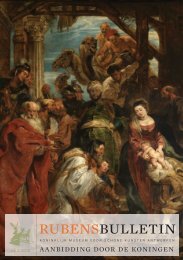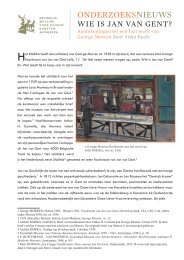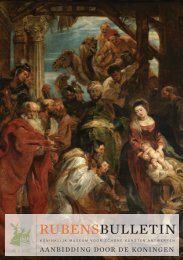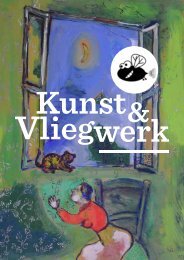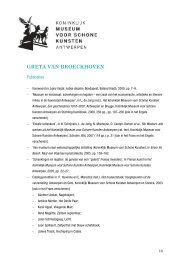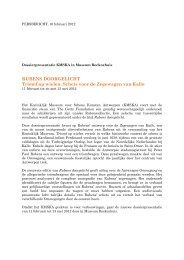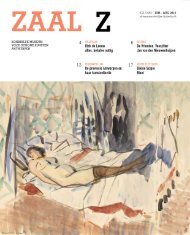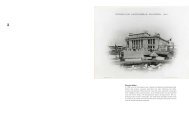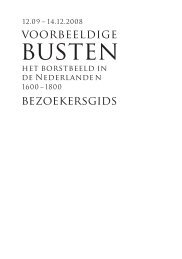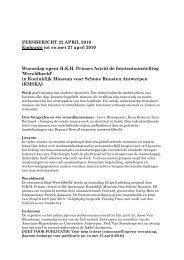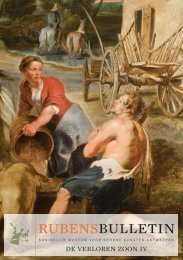Triumph In Antwerp Rubens's oil Sketch - Koninklijk Museum voor ...
Triumph In Antwerp Rubens's oil Sketch - Koninklijk Museum voor ...
Triumph In Antwerp Rubens's oil Sketch - Koninklijk Museum voor ...
You also want an ePaper? Increase the reach of your titles
YUMPU automatically turns print PDFs into web optimized ePapers that Google loves.
BULLETIN<br />
BULLETIN<br />
city hall from Abraham Janssen (1573–1632) in 1609 (fig. 2). 5 This painting<br />
symbolizes the value of the river Scheldt for the city’s welfare and reflects<br />
faith in the restoration of its wealth. However, the truce did not bring any<br />
improvement as <strong>Antwerp</strong>’s access to the sea remained under the control of<br />
the Dutch patrols.<br />
The Battle of Kallo<br />
The Dutch stranglehold on the city had been consolidated in 1585, when<br />
the Spanish troops failed to clear the Dutch from the Scheldt estuary.<br />
<strong>In</strong> 1638, however, the victory at Kallo changed the city’s perspective for<br />
a short period of time. When the Dutch troops were defeated, it looked<br />
as if <strong>Antwerp</strong> were finally ready to resume overseas trade and economic<br />
recovery were imminent. But who could have foreseen that history would<br />
take an other turn for the worse and that ten years later the Peace of<br />
Fig. 3 Map of the fortress of Kallo, published by<br />
Joannes Meyssens, <strong>Antwerp</strong> s.a.<br />
Fig. 4 The failed attack of Count William of Nassau on the fortification of Kallo, etching<br />
Münster (1648) would ratify Dutch mastery of the Scheldt estuary? A<br />
closer look at the course of the Battle of Kallo should clarify the historical<br />
context of Rubens’s design for a triumphal chariot celebrating this victory<br />
gained on the borders of the Scheldt.<br />
After the reconquest of Breda by the Dutch in 1637, the capture of<br />
<strong>Antwerp</strong> was the primary objective of Prince Frederick Henry’s strategy in<br />
the revolt of the Northern Netherlands against Spain. 6 <strong>In</strong> 1638, on their first<br />
campaign after retaking Breda, the Dutch armies moved in the direction of<br />
the river Scheldt (fig. 3).<br />
Despite Frederick Henry’s objections about the moment of attack,<br />
the Dutch deputies and the French allies ordered an immediate raid on the<br />
city of <strong>Antwerp</strong> in June. As a result, Frederick Henry sent the experienced<br />
field marshal Count William of Nassau-Siegen and his six thousand men<br />
in advance to capture the left riverbank, especially the embankment at<br />
Kallo, from where the citadel of <strong>Antwerp</strong> had to be taken. It was planned<br />
that Frederick Henry and his troops would aim for Berchem and that the<br />
combined armies would besiege the city. However, the planned attack<br />
turned into a disaster for the Dutch troops (fig. 4).<br />
William of Nassau managed to occupy the forts of Kallo and<br />
Verrebroek, though not without casualties, as he lost many of his men in the<br />
slush of the wetlands. The two Dutch armies did not meet in accordance<br />
with their military plans, because William decided to stay at Kallo and<br />
5<br />
Panel, 1609, 174 × 308 cm, KMSKA, inv. 212. The Staetencamer of the city hall was the place where<br />
the peace negotiations between the Northern and Southern Netherlands were held. Nico Van Hout,<br />
in Huvenne 2003, p. 86.<br />
6<br />
Blok 1924, p. 210.<br />
44<br />
45




